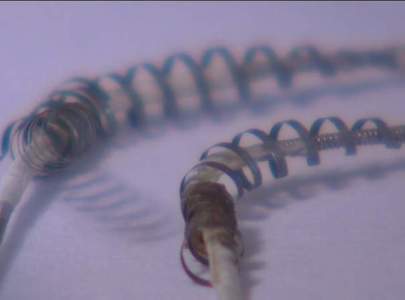Migraines and depression are understood to be neurological diseases though many consider them to be mental illnesses [1, 2]. Recent research sheds light on both conditions and shows us how much they have in common. Both migraines and depression can be stopped by voltage applied to the brain. In the case of depression, voltage has only been applied via open-brain surgical procedures as deep brain stimulation of the specific brain region, shown in the scanner as dark region [3-6]. For migraines the stimulation has been tried both outside of the brain [7, 8] and internally via deep brain electrical stimulation [9]. The cause inn both migraine and depression is seen in scanners [1, 10] as cortically depressed areas. These are dormant regions that have no observable electrical activity. When electrical stimulation is applied to a dormant brain region, it regains its function. Crucially for migraines, it has been demonstrated that a dormant area be shocked by a wave of electricity generated by the brain itself, called cortical spreading depression, energizing the dormant area to be able to create action potential again [11-14]. This is quite similar to a cardiac arrest patient receiving an electrical shock to the heart which restarts electrical activity. The difference is that in the case of the heart the electricity is applied externally by others, whereas in the case of the brain the electric shock is applied by the brain itself by using its functioning brain regions to energize nonperforming regions. Because neurons communicate to each other via neurotransmitters and are connected to each other, neurons that do not manufacture neurotransmitters and do not participate in communication exchange cannot hide. The healthy, energized regions send a wave of energy within the brain. However, this wave reaches the meninges where all pain sensory neurons are located [14] and hence migraine pain.
Similarly to how a cardiac arrest does not always get the heart to continue beating again, the electric shock of the spreading cortical depression may not awaken the dormant regions either. Energy for proper functioning of either the heart or the brain – or indeed for any living tissue – cannot be created from nothing. To continue to generate voltage after the initial shock, the proper minerals have to be available. One can only drive a car on fumes for so long. Interestingly we understand this very well when it comes to our cars but we tend to forget it when it comes to our body. Our body uses energy it receives from what we eat and drink. The energy is carried to the cells by electrolytes. Electrolytes are water mixed with vital nutrients. Electrolytes take up 55%-70% of our body per gender and age with salt about 9 grams per liter. Those brain regions that lack important nutrients will not function.
We now understand that brain regions that are starved of energy and that are not able to generate action potential cause abnormal synaptic transmissions [15, 16]. Yet rather than replenishing the brain by restocking it with nutrients, the current favorite treatment method is some form of serotonin medicine, such as triptans for aborting an ongoing migraine, or serotonin reuptake inhibitors (SSRIs or SNRIs) for prevention for both migraines and depression. Many unlucky migraineurs and depression patients also receive a voltage dependent calcium channel blocker, one of which I discussed in my last article. Given that these medications are so often prescribed, one would think that they actually work. But do they?
They actually don’t work for depression over 70% of the time. And for migraines? Well, that is another story as I am about to discuss. It is also important to note that where energy is needed, medicines that block energization via electrolytes actually work against recovery and dull the brain, using symptom management instead.
Why Triptans and SSRIs/SNRIs are Hit or Miss for Migraines
Serotonin for migraines only works sometimes and even then with tremendous side effects, often causing depression (see adverse reaction tables below), violence, and fatalities. Based on my migraine group where thousands of migraineurs have passed through over the years, the statistics show that 80% of those who join the group take some serotonin preventive, usually an SSRI or SNRI but they still need to take abortives, such as triptans, and yet they still have migraines! Not only does this show that serotonin does not work but also that there is a very dangerous practice of “more is better,” which may be followed by fatal consequences, such as serotonin syndrome. The dangerous practice is common because of five critical reasons:
- Doctors should know better than to prescribe multiple serotonin medications to the same patient and if they don’t know what their patients take, they owe the courtesy to ask before they prescribe!
- Pharmacies have records of all medicines a patient takes. If a doctor makes a mistake, it is the responsibility of the pharmacist to catch the mistake and warn the doctor and the patient. This has never happened in the entire history of my migraine group! I usually analyze their medicines and point out the pharmacological interactions and duplication that they print out and hand to their doctors. Only after the patient’s intervention will doctors initiate removal of dangerous medicines. Last time I checked: The patients are not responsible for the medicines they are being prescribed.
- 85% of the doctors do not recognize serotonin syndrome. The sad truth is that while 100% of the doctors can prescribe SSRIs and similar medications with a few scribbles, 85% of them do not recognize if it reaches toxic levels in their patients. I estimate that the majority of doctors are not familiar with the mechanisms of the medicines they prescribe; they cannot tell if one is a voltage dependent calcium channel blocker or a voltage dependent sodium channel blocker or both or neither.
- This is the saddest of them all: financial incentives actually cause many doctors to be angry with patients who wish to reduce their medicines. Many members in my migraine group faced rude and angry doctors who placed them on such quick reduction from these highly “discontinuations syndrome” (politically correct for addictive) medicines that they were forced back on the medicines and of course that increased again the lunches and dinners or straight cash flow of the prescribing doctors—search out your doctor’s name and see what she/he has been earning on your medicines in 2014!
- The side effects of many of these serotonin medicines are worse than the initial problem they are prescribed for; reduction is slow and painful. While the adverse effects hit all at once when starting a medicine, the very same adverse effects return in slow motion as the patients reduce. For example, they may not even realize that they had increased blood pressure, nausea, dizziness, and diarrhea all at once for a few days or weeks while starting the medication since these adverse effects showed up at once. But in reversing and stopping the medicine, each of these effects can last for weeks and is highly pronounced, frightening the patient. Furthermore, adverse effects are updated on the go by the FDA. Most users are not informed about these by their prescribing physicians.
I randomly picked two very common medications I see prescribed all the time. Zoloft, used for depression, is a selective serotonin reuptake inhibitor (SSRI), and Elavil, a tricyclic antidepressant (TCA), prescribed for migraines frequently. The list of side effects for Zoloft (Sertraline) is huge (Wikipedia). I must say that if I were not depressed before taking this medicine, I most certainly would be after reading this list:
Adverse effects: Fatigue, Insomnia, Somnolence (sleepiness), Nausea, Dry mouth, Diarrhea, Headache, Ejaculation disorder, Dizziness, Agitation, Anorexia, Constipation, Dyspepsia (indigestion), Decreased libido, Sweating, Tremor, Vomiting, Impaired concentration, Nervousness, Paroniria (i.e., depraved or morbid dreaming/nightmares), Yawning, Palpitations, Increased sweating, Hot flushes, Weight decrease, Weight increase, Myoclonus, Hypertonia, Bruxism (teeth grinding), Hypoesthesia, Menstrual irregularities, Sexual dysfunction, Rash, Vision abnormal, Asthenia, Chest pain, Paranesthesia, Tinnitus (hearing ringing in the ears), Hypertension (high blood pressure), Hyperkinesia, Bronchospasm, Esophagitis (swollen esophagus), Dysphagia, Hemorrhoids, Periorbital Edema, Purpura, Cold Sweat, Dry skin, Nocturia, Urinary Retention, Polyuria (excessive urination), Vaginal Hemorrhage, Malaise, Chills, Pyrexia (fever), Thirst, Pollakiuria, Micturition disorder, Salivary Hypersecretion, Tongue Disorder, Osteoarthritis, Muscular Weakness, Back Pain, Muscle Twitching, Eructation (belching), Dyspnea (air hunger), Epistaxis (nose bleed), Edema peripheral, Periorbital edema, Syncope, Postural dizziness, Tachycardia (high heart rate), Urticaria (hives), Migraine, Abnormal bleeding (esp. in the GI tract), Muscle cramps, Arthralgia, Depressive symptoms, Euphoria, Hallucination, Alopecia (hair loss), Urinary Retention (being unable to pass urine), Pruritus, Amnesia memory loss., Urinary incontinence, Eye pain, Asymptomatic elevations in serum transaminases, Abnormal semen, Melena (black feces due to a bleed in the stomach), Coffee ground vomiting, Hematochezia, Stomatitis (swollen mouth), Tongue ulceration, Tooth Disorder, Glossitis (soreness/swelling of the tongue), Mouth Ulceration, Laryngospasm, Hyperventilation (breathing more often than required to keep one’s blood sufficiently oxygenated), Hypoventilation (breathing less often than required to keep one’s blood sufficiently oxygenated), Stridor, Dysphonia (voice disorder), Upper Respiratory Tract Infection, Rhinitis (irritation/inflammation inside the nose), Hiccups, Apathy, Thinking Abnormal, Allergic reaction, Allergy, Anaphylactoid reaction, Face edema, Priapism, Atrial arrhythmia, AV block, Coma, Peripheral Ischemia, Injury, Vasodilation Procedure, Lymphadenopathy, Involuntary muscle contractions, Galactorrhea (lactation that is unrelated to pregnancy or breastfeeding), Gynecomastia (swelling of breast tissue in men), Hyperprolactinemia (high blood prolactin levels), Hypothyroidism (underactive thyroid gland), Syndrome of inappropriate secretion of antidiuretic hormone (SIADH), Pancreatitis (swollen pancreas), Altered platelet function, Hematuria (blood in the urine), Leukopenia (low white blood cell count), Thrombocytopenia (low blood platelet count), Increased coagulation times, Abnormal clinical laboratory results, Hyponatremia (low blood sodium), Conversion Disorder, Drug Dependence, Paranoia, Myocardial Infarction (heart attack), Bradycardia, Cardiac Disorder, Suicidal Ideation/behavior, Sleep Walking, Premature Ejaculation, Hyperglycemia (high blood sugar), Hypoglycemia (low blood sugar), Hypercholesterolemia (high blood cholesterol), Vasculitis, Aggressive reaction, Psychosis (hallucinations and delusions), Mania (a dangerously elated mood), Menorrhagia (an abnormally excessive amount of menstrual bleeding), Atrophic Vulvovaginitis, Balanoposthitis, Genital Discharge, Angioedema, Photosensitivity skin reaction, Enuresis, Visual field defect, Abnormal liver function, Dermatitis, Dermatitis Bullous, Rash Follicular, Glaucoma, Lacrimal Disorder, Scotoma, Diplopia, Photophobia, Hyphemia, Mydriasis, Hair Texture Abnormal, Neoplasm, Diverticulitis, Choreoathetosis, Dyskinesia, Hyperesthesia, Sensory Disturbance, Gastroenteritis, Otitis Media, Skin Odour Abnormal, QTc prolongation, Anaphylactoid Reaction, Allergic Reaction, Allergy, Neuroleptic malignant syndrome. A potentially fatal reaction that most often occurs as a result of the use of antipsychotic drugs. It is characterized by fever, muscle rigidity, rhabdomyolysis (muscle breakdown), profuse sweating, tachycardia, tachypnoea (rapid breathing), agitation, Stevens-Johnson syndrome a potentially fatal skin reaction, Toxic epidermal necrolysis another potentially fatal skin reaction, Torsades de pointes a potentially fatal change in the heart’s rhythm., Cerebrovascular spasm, Serotonin syndrome similar to neuroleptic malignant syndrome but develops more rapidly (over a period of hours instead of days/weeks for neuroleptic malignant syndrome), Bone fracture, Movement disorders, Diabetes mellitus, Dyspnea, Jaundice yellowing of the skin, mucous membranes and eyes due to an impaired ability of the liver to clear the haem breakdown by product, bilirubin, Hepatitis, Liver failure. This medicine can cause serotonin syndrome on its own.
For migraine I picked Elavil (Amitriptyline) which is a TCA. While it has fewer side effects (Wikipedia) than Sertraline (SSRI), one of its major side effects is headache. Why would a competent doctor prescribe a known headache causer to a migraineur?
Here are some of the other adverse effects: dizziness, headache, weight gain, delirium, confusion, anxiety, agitation, orthostatic hypotension (low blood pressure), sinus tachycardia, loss of libido, impotence, sleep disturbances such as drowsiness and insomnia. Most importantly, Amitriptyline inhibits sodium channels, L-type calcium channels, and voltage-gated potassium channels, and therefore acts as a sodium, calcium, and potassium channel blocker as well.
Recall my argument of a car only able to go on fumes for so long? This drug, by blocking all possible energizing channels, blocks the inflow of nutrients and the outflow of toxins. This car is not going anywhere!
Yet many migraineurs who join my group have been taking Elavil, which of course doesn’t work, so then they end up having to take several other medicines to replace activities the brain cannot do: they often receive prescriptions for other types of SSRIs, sometimes voltage dependent calcium blockers, barbiturates, NSADs, muscle relaxers, steroids and even triptans to come full circle, and add the very ingredient they blocked from being released the first place!
Does Serotonin Use Make Any Sense At All?
When a brain region is not able to generate action potential, as shown, lack of serotonin is not the cause. It is entirely possible that the particular neurons that cannot generate enough energy happen to be responsible for serotonin production, in which case adding serotonin will indeed take the pain away. However, it will not treat the underlying cause of not having enough energy for generating action potential. The fact that it is energy shortage rather than serotonin shortage that causes depression is clearly demonstrated by the deep brain stimulation experiments on live humans, where the voltage stimulation lifted their depression right there during the experiment without any serotonin. The patients were able to explain what they felt and how their depression lifted during the procedure [4-6, 17]. It all sounds very simple actually since we know what generates action potential in the brain: salt.
So why do migraine and depression sufferers keep on getting serotonin medications knowing that serotonin has absolutely nothing to do with migraines? This is a great question that I would like to ask many physicians! Habits are hard to break but eventually they must!
Concluding Thoughts
There is only a small chance that triptans or SSRIs will work for your migraines or depression but it is 100% certain that adverse effects will prevent your brain from working properly. In the long run, these drugs cause permanent damage. Do yourself a favor and learn what migraines are and how to prevent them. Since migraines and depression have the same cause as seen in the scanners, why not try the same solution? Many who joined my migraine group with depression and migraine are now free of both, as well as all their medicines! Join the movement for healthy life without medicines.
Sources
- Gasparini, C.F., H.G. Sutherland, and L.R. Griffiths, Studies on the Pathophysiology and Genetic Basis of Migraine. Current Genomics, 2013. 14(5): p. 300-315.
- Young, W.B., et al., The Stigma of Migraine. PLoS ONE, 2013. 8(1): p. e54074.
- Holtzheimer, P.E., et al., Subcallosal Cingulate Deep Brain Stimulation for Treatment-Resistant Unipolar and Bipolar Depression. Jama Psychiatry, 2012: p. 150-158.
- Lozano, A.M., et al., A multicenter pilot study of subcallosal cingulate area deep brain stimulation for treatment-resistant depression. J Neurosurg, 2012: p. 315-322.
- Mayberg, H.S., et al., Deep brain stimulation for treatment-resistant depression, in Neuron. 2005. p. 651-60.
- Taghva, A.S., D.A. Malone, and A.R. Rezai, Deep brain stimulation for treatment-resistant depression. World Neurosurg., 2013: p. 826-831.
- Aurora, S.K., et al., Transcranial magnetic stimulation confirms hyperexcitability of occipital cortex in migraine, in Neurology. 1998. p. 1111-4.
- DaSilva, A.F., et al., tDCS-Induced Analgesia and Electrical Fields in Pain-Related Neural Networks in Chronic Migraine. Headache: The Journal of Head and Face Pain, 2012. 52(8): p. 1283-1295.
- Tepper, S.J., et al., Acute Treatment of Intractable Migraine With Sphenopalatine Ganglion Electrical Stimulation. Headache: The Journal of Head and Face Pain, 2009. 49(7): p. 983-989.
- Hadjikhani, N., et al., Mechanisms of migraine aura revealed by functional MRI in human visual cortex. Proceedings of the National Academy of Sciences, 2001. 98(8): p. 4687-4692.
- Charles, A.C. and S.M. Baca, Cortical spreading depression and migraine. Nat Rev Neurol, 2013: p. 637-44.
- James, M.F., et al., Cortical spreading depression and migraine: new insights from imaging? TRENDS In Neuroscience, 2001: p. 226-271.
- Lauritzen, et al., Clinical relevance of cortical spreading depression in neurological disorders: migraine, malignant stroke, subarachnoid and intracranial hemorrhage, and traumatic brain injury, in J Cereb Blood Flow Metab. 2011. p. 17-35.
- Bolay, H., et al., Intrinsic brain activity triggers trigeminal meningeal afferents in a migraine model. Nat Med, 2002. 8(2): p. 136-142.
- Pietrobon, D., Insights into migraine mechanisms and Ca(V)2.1 calcium channel function from mouse models of familial hemiplegic migraine. The Journal of Physiology, 2010. 588(Pt 11): p. 1871-1878.
- Vecchia, D., et al., Abnormal cortical synaptic transmission in CaV2.1 knockin mice with the S218L missense mutation which causes a severe familial hemiplegic migraine syndrome in humans. Front. Cell. Neurosci., 2015: p. epub ahead of print.
- Lozano, M. and N. Lipsman, Probing and regulating dysfunctional circuits using deep brain stimulation, in Neuron. 2013. p. 406-24.













Hi, I was given at the ER acetaminophen, Dexamethasone and compazine for a migraine through and IV and immediately after I started having horrible anxiety, hot flashes, Restlessness and a lot of fear, I just wanted to cry and cry, it was horrible, it lasted for about a week, but I still am suffering from chest pain, diarrhea, high blood pressure, do you think it can be SS? Will it go away?
Dear Alexa,
I am very sorry about your experience. There was no serotonin in any of the medications you received in the ER so unless you are taking a medication that increases serotonin that you didn’t list, I don’t know how you would have serotonin syndrome.
For the future: if you have migraine, please join my group on Facebook, and also read my book on migraine. Migraine can be aborted and prevented without medicines. It’s nothing complicated.
Best wishes for your recovery,
Angela
*Elavil is not an SNRI, it is a Tricyclic antidepressant.
Very true Erik, thanks for the correction. Not sure if the Elavil was the typo or the SNRI; it’s a very old article.
Thanks,
Angela